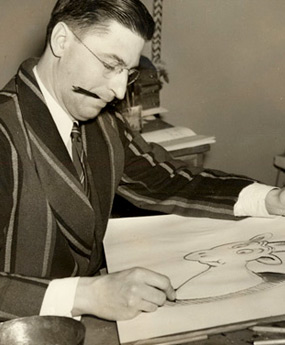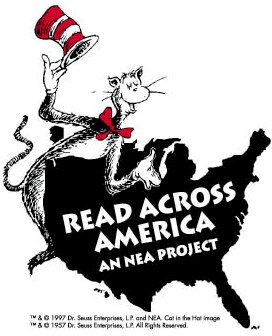 As a famous author whose life spanned the twentieth century, Dr. Seuss (1904-1991) should have been often in newsreels and on TV, right? From time to time, he does appear on camera – but less often than we might expect. In celebration of what would have been his 112th birthday, here’s a brief (but far from complete) collection of Seuss on film!
As a famous author whose life spanned the twentieth century, Dr. Seuss (1904-1991) should have been often in newsreels and on TV, right? From time to time, he does appear on camera – but less often than we might expect. In celebration of what would have been his 112th birthday, here’s a brief (but far from complete) collection of Seuss on film!
Below, are four film clips – two from the 1940s, one from 1958, and one from 1964. All are short: Unusual Occupations (1940) is 2 minutes, he’s only in the first 45 seconds of Making SNAFU (c. 1943), To Tell the Truth (1958) is under 8 minutes, and the New Zealand schoolroom (1964) is under 4 minutes.  However, if you’re running short on time, skip ahead to the New Zealand schoolroom.  That’s my favorite of the group.
Two of these (c. 1943, 1958) were already on YouTube, but the other two (1940, 1964) are – as far as I know – making their YouTube debut today. Enjoy!
Unusual Occupations (1940)
The earliest known film footage of Dr. Seuss is in color!  Sadly, there’s no audio. But you do get to see him with the sculptures he was making. He called them “Unorthodox Taxidermy” and sold them via mail.  Though his fourth children’s book (Horton Hatches the Egg) was published the same year as this clip, Seuss’s main occupation at this time was advertising: the “Seuss Navy” line in the narration references his adds for Esso.  Also, though the narrator describes him as a “doctor of literature,” he wasn’t.  He dropped out of his M.A. program, and never pursued the Ph.D.  But he did use “Dr.” for his professional pseudonym.
Horton Hatches the Egg would be Seuss’s last children’s book until 1947. With the World War raging in Europe and the Pacific, Seuss set aside children’s books and “Unorthodox Taxidermy.” Instead, he began working on propaganda – first, political cartoons, and next, educational videos for the U.S. Army.
Making SNAFU (c. 1943)
In April 1941, Theodor Seuss Geisel – a.k.a. Dr. Seuss – became a political cartoonist for PM, New York’s Popular Front newspaper. Convinced that America would be drawn into the rapidly expanding World War, he feared that isolationism made the United States vulnerable.  As he recalled,
The way I went to work for PM is that I got annoyed with Lindbergh and his America-Firsters. I was already somewhat prominent as a cartoonist, but nobody would print my cartoons against Lindbergh. So I went to work for PM for almost nothing. When the United States got into the war I started receiving a lot of letters saying I was a dirty old man who had helped get us into the war, and I was too old to fight. So I enlisted.
In January 1943, after having written over 400 political cartoons for PM, Geisel left New York and took the train out to Hollywood, California, where he would be a captain in the U.S. Army’s Information and Education Division – “Fort Fox,” headed by Major Frank Capra, the Oscar-winning director.
Capra placed Ted Geisel in charge of the animation branch and assigned him to make educational films that would run in the Army-Navy Screen Magazine, a biweekly newsreel shown to the troops. Ted Geisel and Phil Eastman (later famous for Go, Dog. Go!, but then an ex-Disney animator)Â teamed up with directors Chuck Jones and Friz Freleng; vocal impressionist Mel Blanc; composer Carl Stalling; and the other creative minds behind Bugs Bunny, Daffy Duck, and Porky Pig. Exactly who came up with the idea of Private SNAFU is not clear, but the idea itself was simple: Teaching by negative example, Private SNAFU would embody his name, an acronym for (as the first cartoon put it) “Situation Normal All … All Fouled Up.”1
In the clip below, you’ll see Ted Geisel, at the desk on the left (0:15-0:40).  As Jerry Beck says, the clip is “unedited footage shot by the First Motion Picture unit, likely intended to be used for a newsreel or other production.”  They’ve added some of Stalling’s score (from SNAFU shorts) as a soundtrack. Though Beck lists this piece as circa 1944, I think it slightly more likely to have been 1943: once the SNAFU cartoons started being screened (July 1943), they were very popular. By 1944, there would have been no need to create promotional footage. But either date is close enough.
To Tell the Truth (1958)
Up until 1957, Seuss was more famous for his advertising work than his children’s books. Then, he published The Cat in the Hat (spring, 1957) and How the Grinch Stole Christmas! (fall, 1957) – both of which were very popular and, to this day, remain two of his best-known works. Buoyed by this popularity, he appeared on the April 29, 1958 episode of the TV quiz show To Tell the Truth.
New Zealand TV (1964)
During a book tour in Australia and New Zealand, Seuss visited Auckland’s May Road School, where this film was made. This is my favorite footage of Dr. Seuss because he’s improvising with the children, playfully answering their questions with what he was by then calling “logical nonsense.” I also like it because it refutes the oft-repeated claim that Seuss did not like children. His response to children was similar to his response to adults: he liked some, and not others.
Notes:
- All information in this and preceding “Making SNAFU” paragraphs lifted from the opening of my article “Children’s Literature Goes to War: Dr. Seuss, P.D. Eastman, Munro Leaf, and the Private SNAFU Films (1943-46),” The Journal of Popular Culture 40.3 (June 2007), pp. 468-69. <www.blackwell-synergy.com/doi/full/10.1111/j.1540-5931.2007.00404.x> (Full text available to subscribers.)
Since it is Seuss’s birthday, you might enjoy perusing other posts tagged Seuss. Here’s a selection:
- No Seuss Better Than Faux Seuss (27 July 2015). On bad imitation Seuss verse, contrasted with good imitation – provided via audio of David Rakoff’s excellent “Samsa and Seuss.”
- Six Spots of Seuss News (2 Mar. 2015). On What Pet Should I Get?, Elana Kagan’s citation of One fish two fish red fish blue fish (1960) in a 2015 Supreme Court decision written by Justice Elena Kagan, Dr. Seuss advertising art from 1936, and a Dr. Seuss rap quiz!
- Was the Cat in the Hat Black? (22 June 2014). An excerpt from an essay, in which I explore Dr. Seuss’s racial imagination. Also, the title for my next book, due from Oxford UP later this year (2016).
- Oh, the Quotations You’ll Forge! (2 Mar. 2014). Seuss’s pithy verse is very quotable. Unfortunately, people have a habit of attributing things to him that he never said. This post exposes some fake Seuss, and gives you plenty of quotations that he actually did say.
- Happy birthday to Dr. Seuss! A guest post by Charles D. Cohen (2 Mar. 2013). Â Birthday reflections from Seussologist Charles Cohen (The Seuss, the Whole Seuss, and Nothing But the Seuss). Quotes some original verse by Seuss, including “Pentellic Bilge for Bennett Cerf’s Birthday” (1940).
- How to Mispronounce “Dr. Seuss” (6 Feb. 2013). Also: how to pronounce “Dr. Seuss.”
- I Am the Lorax. I Speak for the Theeds? (3 Mar. 2012). Some thoughts on The Lorax film and its attendant advertising.
- Dr. Seuss: children’s books “have a greater potential for good or evil, than any other form of literature on earth.” (1 Mar. 2012). A 1960 essay by Seuss on writing for children.
- Dr. Seuss on “conditioned laughter,” racist humor, and why adults are “obsolete children” (16 Jan. 2012). A 1952 essay by Seuss on humor.
- Seussology (15 Jan. 2012): On my graduate-level “Dr. Seuss” course.
- Oh, the Thinks That He Thought! Some of Seuss’s Lesser-Known Works (2 Mar. 2011): My post for Dr. Seuss’s birthday in 2011.
- You’re a Mean One, Mr. Grinch (20 Dec. 2010): 15 versions of the song.
- Corporate Seuss; or, Oh, the Things You Can Sell! (21 Aug. 2010). Ted Geisel was first famous for advertising, not children’s books.
From time to time, I get asked to talk about Dr. Seuss:
- Joshua Barajas, “8 Things You Didn’t Know About Dr. Seuss,” PBS News Hour blog, 22 July 2015.
- “New Window into Dr. Seuss’s genius” (26 Feb. 2014). John Wilkens’ article in the San Diego Tribune discusses new Seuss material that his widow, Audrey, donated to the Dr. Seuss Papers at UCSD.
- “Dr. Seuss: Mini-Biography.” A&E Biography (2013).  Time: 4 minutes.
- All Things Considered. Lynn Neary, “‘The Bippolo Seed’ : The ‘Lost’ Dr. Seuss Stories” (13 Apr. 2011):Â audio & transcript. Â Charles Cohen & I talk about the new book of “lost” Seuss stories (edited by Charles). Â Time: 3 mins, 30 secs.
- Diane Rehm Show. Dr. Seuss’s How the Grinch Stole Christmas! (22 Dec. 2010): audio | transcript. Reverend Derrick Harkins, Maria Salvadore, and I talk with Diane Rehm about the Grinch.  Time: 1 hour.
- Morning Edition. Lynn Neary, “Fifty Years of The Cat in the Hat” (1 Mar. 2007):Â audio & transcript. Anita Silvey and I talk with Lynn Neary about the Cat in the Hat. Â Time: 7 mins, 20 secs.
- Talk of the Nation. Â Steve Inskeep, “Celebrating the 100th Birthday of Dr. Seuss: A New Book Looks Back on the Life of Theodor Geisel” (10 Feb. 2004):Â audio. Â I was a bit nervous at the beginning (I believe it was my first time on live national radio), but after the first few minutes I seem to settle into it well enough. Â Time: 1 hour.
| Though the website design impedes its utility, Random House’s Seussville‘s author section includes a bio. and timeline I wrote – the former heavily influenced by Judith and Neil Morgan’s excellent Dr. Seuss & Mr. Geisel.  (If you read only one book about Dr. Seuss, the Morgans’ bio is the one I’d recommend.) Happy Read Across America Day!*
*Each year on or near March 2nd (the birthday of Theodor Seuss Geisel, a.k.a. Dr. Seuss), the National Education Association sponsors Read Across America, designed to promote literacy. This year, it’s being celebrated on Wednesday, March 2nd. Read more about it at the NEA’s website. |
 |

Fuse #8
Philip Nel
Pingback: hotTEAs of Children’s Literature: Philip Nel | Jama's Alphabet Soup
Iza Trapani-Hare